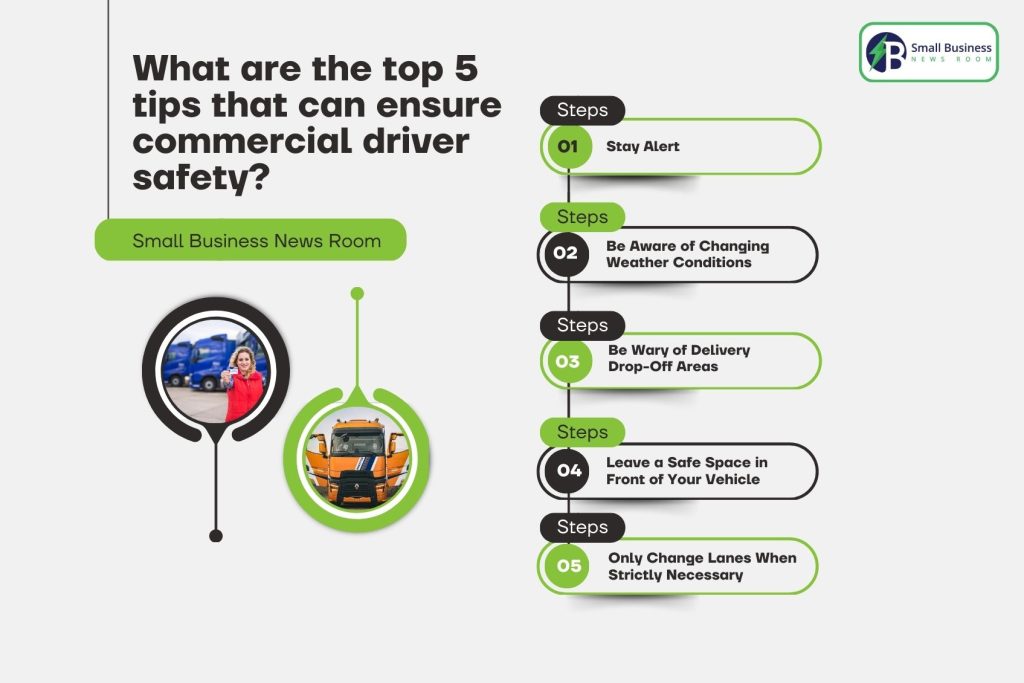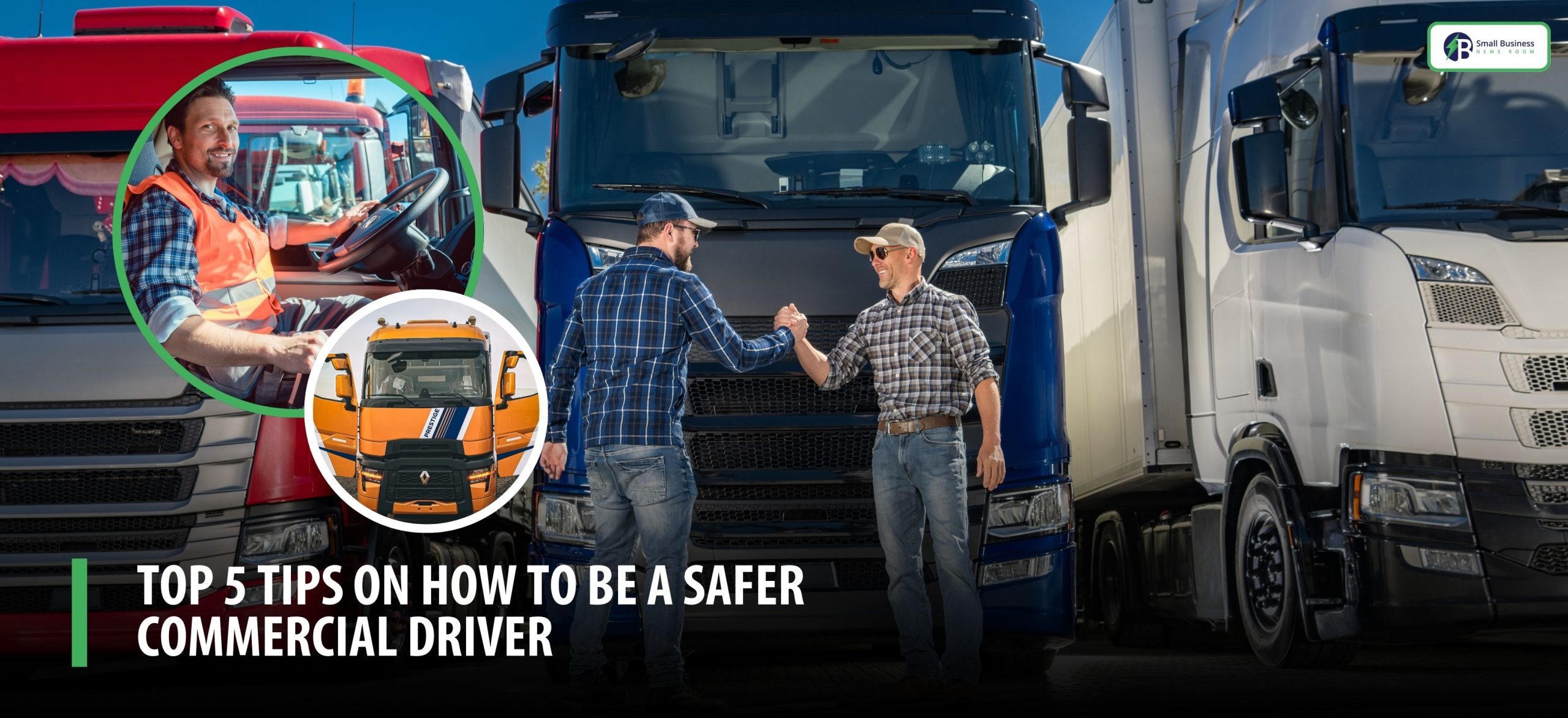Table Of Contents
- Top 5 Tips On How To Be A Safer Commercial Driver
- 1. Stay Alert
- 2. Be Aware of Changing Weather Conditions
- 3. Be Wary of Delivery Drop-Off Areas
- 4. Leave a Safe Space in Front of Your Vehicle
- 5. Only Change Lanes When Strictly Necessary
- Why Safety is Important for Company Truckers
- Shared Risks Faced by Commercial Truckers
- Habits of the safest drivers
- The Importance of Sleep, Food, and Mobility
- Technology for the Protection of the Driver
Top 5 Tips On How To Be A Safer Commercial Driver
Last Updated on: September 9th, 2025
Commercial drivers need exceptional skills and tactics! This way, they are able to manage all their vehicles under all sorts of road conditions.
And, when I say road conditions, it includes heavy traffic, inclement weather and more other situations. These can make it dangerous for you to drive on the roads. Safety is the number one priority for every truck or van driver.
Whether you own a fleet of commercial vehicles or you are just behind the wheel, the overall principles of safety always remain constant!
One accident can ruin a career and many lives. Below we provide the reader with tips on how to be a safer commercial driver.
Top 5 Tips On How To Be A Safer Commercial Driver

From defensive driving to better load securement or fatigue management, these top 5 tips can help you to ensure better commercial driver safety. Read on…
1. Stay Alert
There is no room for neglecting this principle at any time. Accidents happen quickly and unexpectedly and are more likely if the drivers involved have lost concentration or taken chances without adhering to safety rules.
Commercial drivers need to be aware of everything taking place on the road, up ahead, to the sides, and behind. Specific attention must be paid to blind spots. Plan your moves. Check again and signal correctly before leaving your lane or taking an exit or onramp. Don’t take chances, ever.
2. Be Aware of Changing Weather Conditions
Stay tuned to updates on changing weather conditions. Monitor the weather for yourself as you drive. Use an outside temperature gauge. Adjust your driving to road conditions.
3. Be Wary of Delivery Drop-Off Areas

Low-lying objects are invisible from inside your truck. So, select a safe parking spot and get out to check the zone on foot. Make sure you will have enough room to both enter and exit without damaging your vehicle. Take note of pedestrians in the vicinity who are probably unaware of your range of visibility. This will help you keep a clean driving record.
4. Leave a Safe Space in Front of Your Vehicle
Leave a safe space in front of your vehicle. This is common sense but often ignored. Commercial drivers can become frustrated when:
- Cars whizz past at higher speeds,
- Overtake recklessly, and
- Discount trucks on the road.
Let’s say you hit a vehicle in front of you. In that case, you will be held responsible! So, you must try to keep a good buffer area between the front of your truck and other vehicles to give you that extra second to respond to changing conditions appropriately and safely.
Slow down if someone pushes in front of you. Remember that you have a job to do and you are not there to compete with other drivers. Read Fleet Driver Safety News for more information on buffer zones.
5. Only Change Lanes When Strictly Necessary

Determine the best lane to be in and stay there. If it is necessary to change lanes, first check your blind spots and signal your intention. Wait until it is safe to execute your maneuver. Every lane change by any vehicle could be a potential accident so be aware of what other drivers around you are doing as well. Beware of places where lanes merge. Many cars see this as a race to be the first one through the gap. If there is a lane to the right of the merging lane, stick to it.
Be a responsible driver at all times and avoid costly and heart-breaking accidents.
Why Safety is Important for Company Truckers
It is also not the same as driving an ordinary car. Delivery vans and lorries are larger, longer to stop, and have larger blind spots. This is why the smallest mistake could result in serious issues.
Besides personal safety, accidents can impact:
- Your career: Too many accidents or violations can cost you your job.
- Company reputation: Safe drivers help businesses gain trust from customers.
- Other individuals: Pedestrians or smaller vehicles are more vulnerable during accidents.
Safe doesn’t equate to rules; safe equates to keeping the lives safe, including yours.
Shared Risks Faced by Commercial Truckers
Commercial truckers face a variety of shared risks that can be categorized into physical, economic, and psychosocial hazards, which can significantly impact their health, safety, and financial stability.
Let’s take a look at the shared risks that are being faced by commercial truck drivers.
- Fatigue: Driving for many hours can make you sleepy.
- Distractions such as cell phones, GPS devices, or even snacking/drinking while driving cause accidents.
- Weather hazards: Precipitation, fog, and snow reduce visibility and controllability.
- Other road-users: Truck stopping distances are underestimated by many car drivers.
Once they are aware of all the potential risks, it becomes easy for them to avoid them.
Habits of the safest drivers
The safest commercial truck drivers practice defensive driving, maintain their vehicle diligently, manage fatigue, and remain constantly aware of their surroundings.
They are disciplined professionals who prioritize safety over schedule and take full responsibility for their vehicle and cargo.
- The greatest commercial drivers sometimes possess similar tendencies:
- They rest properly before a shift.
- They notice traffic lights even when others ignore.
- It never multitasks when driving.
- They remain unfazed, even when others pass aggressively.
The Importance of Sleep, Food, and Mobility
Your physical health is highly relevant to how safe you will be on the road.
- Rest: Sleepiness also decelerates the ability to react. Get 7–8 hours.
- Food: High-fat lunches will cause drowsiness. You can always select smaller lunches when on the job.
- Fitness: Try to keep yourself engaged with moderate physical activity. This helps with alertness and stamina, especially on long flights.
Technology for the Protection of the Driver
The recent technologies have been playing a huge role in protecting and achieving commercial truck safety.
This can further enhance safety while preventing all sorts of collisions. These systems integrate data from sensors, cameras, and telematics to monitor driver behavior and vehicle performance in real time.
There are also safety measures in the new car that help lower accidents:
- Lane change notices
- Blind spot monitoring
- collision alerting
GPS route planning for unsafe road avoidance. Learning how to use these tools effectively can make your job easier and safer.















